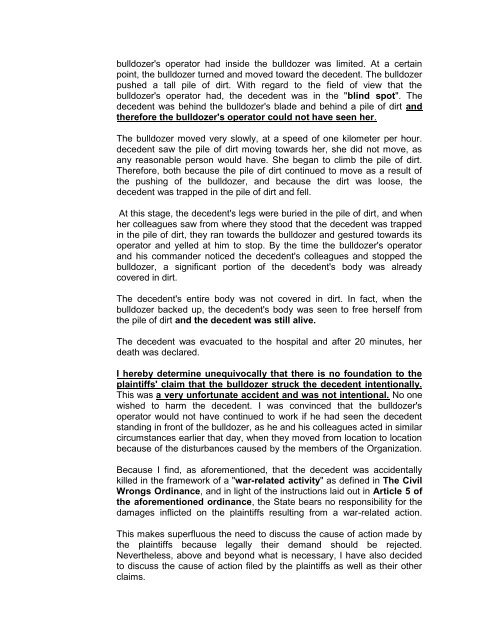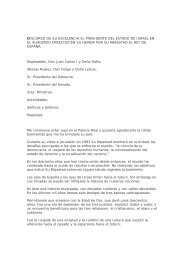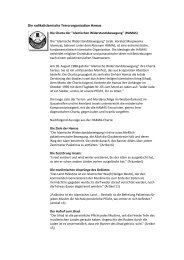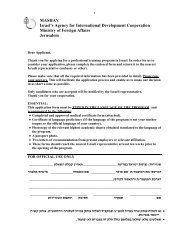Summary of the Verdict (TA 371/05) Estate of the Late Rachel Corrie ...
Summary of the Verdict (TA 371/05) Estate of the Late Rachel Corrie ...
Summary of the Verdict (TA 371/05) Estate of the Late Rachel Corrie ...
Create successful ePaper yourself
Turn your PDF publications into a flip-book with our unique Google optimized e-Paper software.
ulldozer's operator had inside <strong>the</strong> bulldozer was limited. At a certain<br />
point, <strong>the</strong> bulldozer turned and moved toward <strong>the</strong> decedent. The bulldozer<br />
pushed a tall pile <strong>of</strong> dirt. With regard to <strong>the</strong> field <strong>of</strong> view that <strong>the</strong><br />
bulldozer's operator had, <strong>the</strong> decedent was in <strong>the</strong> "blind spot". The<br />
decedent was behind <strong>the</strong> bulldozer's blade and behind a pile <strong>of</strong> dirt and<br />
<strong>the</strong>refore <strong>the</strong> bulldozer's operator could not have seen her.<br />
The bulldozer moved very slowly, at a speed <strong>of</strong> one kilometer per hour.<br />
decedent saw <strong>the</strong> pile <strong>of</strong> dirt moving towards her, she did not move, as<br />
any reasonable person would have. She began to climb <strong>the</strong> pile <strong>of</strong> dirt.<br />
Therefore, both because <strong>the</strong> pile <strong>of</strong> dirt continued to move as a result <strong>of</strong><br />
<strong>the</strong> pushing <strong>of</strong> <strong>the</strong> bulldozer, and because <strong>the</strong> dirt was loose, <strong>the</strong><br />
decedent was trapped in <strong>the</strong> pile <strong>of</strong> dirt and fell.<br />
At this stage, <strong>the</strong> decedent's legs were buried in <strong>the</strong> pile <strong>of</strong> dirt, and when<br />
her colleagues saw from where <strong>the</strong>y stood that <strong>the</strong> decedent was trapped<br />
in <strong>the</strong> pile <strong>of</strong> dirt, <strong>the</strong>y ran towards <strong>the</strong> bulldozer and gestured towards its<br />
operator and yelled at him to stop. By <strong>the</strong> time <strong>the</strong> bulldozer's operator<br />
and his commander noticed <strong>the</strong> decedent's colleagues and stopped <strong>the</strong><br />
bulldozer, a significant portion <strong>of</strong> <strong>the</strong> decedent's body was already<br />
covered in dirt.<br />
The decedent's entire body was not covered in dirt. In fact, when <strong>the</strong><br />
bulldozer backed up, <strong>the</strong> decedent's body was seen to free herself from<br />
<strong>the</strong> pile <strong>of</strong> dirt and <strong>the</strong> decedent was still alive.<br />
The decedent was evacuated to <strong>the</strong> hospital and after 20 minutes, her<br />
death was declared.<br />
I hereby determine unequivocally that <strong>the</strong>re is no foundation to <strong>the</strong><br />
plaintiffs' claim that <strong>the</strong> bulldozer struck <strong>the</strong> decedent intentionally.<br />
This was a very unfortunate accident and was not intentional. No one<br />
wished to harm <strong>the</strong> decedent. I was convinced that <strong>the</strong> bulldozer's<br />
operator would not have continued to work if he had seen <strong>the</strong> decedent<br />
standing in front <strong>of</strong> <strong>the</strong> bulldozer, as he and his colleagues acted in similar<br />
circumstances earlier that day, when <strong>the</strong>y moved from location to location<br />
because <strong>of</strong> <strong>the</strong> disturbances caused by <strong>the</strong> members <strong>of</strong> <strong>the</strong> Organization.<br />
Because I find, as aforementioned, that <strong>the</strong> decedent was accidentally<br />
killed in <strong>the</strong> framework <strong>of</strong> a "war-related activity" as defined in The Civil<br />
Wrongs Ordinance, and in light <strong>of</strong> <strong>the</strong> instructions laid out in Article 5 <strong>of</strong><br />
<strong>the</strong> aforementioned ordinance, <strong>the</strong> State bears no responsibility for <strong>the</strong><br />
damages inflicted on <strong>the</strong> plaintiffs resulting from a war-related action.<br />
This makes superfluous <strong>the</strong> need to discuss <strong>the</strong> cause <strong>of</strong> action made by<br />
<strong>the</strong> plaintiffs because legally <strong>the</strong>ir demand should be rejected.<br />
Never<strong>the</strong>less, above and beyond what is necessary, I have also decided<br />
to discuss <strong>the</strong> cause <strong>of</strong> action filed by <strong>the</strong> plaintiffs as well as <strong>the</strong>ir o<strong>the</strong>r<br />
claims.
















